duets: alto flute and piano
Bauer - Sonata - Alto Flute
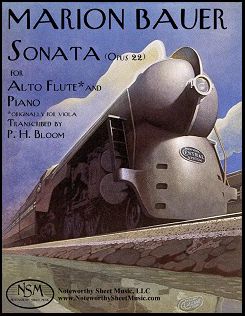 Sonata, Op.22, by Marion Bauer
Sonata, Op.22, by Marion Bauer
Transcribed for Alto Flute by Peter H. Bloom (originally for viola)
Alto Flute Part, PDF $11.79
The following notes are excerpted, with permission, from the complete copyrighted foreword written by Peter H. Bloom for the Noteworthy Sheet Music edition of his transcription:
"The career of Marion Eugenie Bauer (1882-1955) as a composer, editor, writer, teacher, supportive colleague and mentor continues to assert a significant impact on the trajectory of American Music. It's mysterious that her legacy has been so rarely recalled and her music so infrequently performed in the six decades following her death. ... In 1906 she was the first of generations of American composers to study in Paris with the redoubtable Nadia Boulanger. ... We're fortunate that the composer crafted her own superb transcription of this sonata for clarinet and piano. In order to achieve the equivalent musical impact, her viola and clarinet versions differ in some places. The piano part, nevertheless, remains unchanged. Sometimes we've opted for the clarinet version, sometimes the viola version, and sometimes a conflation of the two. We have also made a few adaptive changes in tessitura, articulation, phrasing and dynamics to highlight the unique voice of the alto flute. Though execution may occasionally differ, the rhetorical and emotional shape of the work remains essentially the same."
P. H. Bloom, © January 7, 2014
We provide our alto flute transcription; the piano part is readily available as a free pdf download of the score from sources such as imslp.org/.
Alto Flute part, 9 pages of music; Total, 12 pages.
PreviewBeach - 3 Compositions - Alto Flute & Piano
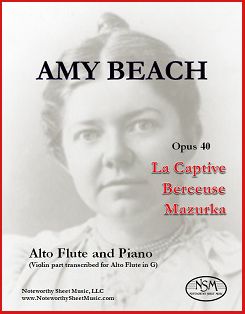 3 Compositions, Op.40, by Amy Beach
3 Compositions, Op.40, by Amy Beach
Transcribed for Alto Flute and Piano by C.A.Vater
Piano Score and Alto Flute Part, PDF $10.50
Amy Marcy Cheney was born in Henniker, New Hampshire in 1867 and began composing music at the age of four. Initially home-schooled as a pianist, she continued her music studies in Boston and made her professional debut as a pianist at age 16. She later became a soloist with the Boston Symphony Orchestra. At 18, she married the prominent Boston physician Dr. Henry Harris Aubrey Beach and began using "Mrs. H. H. A. Beach" as her professional name. She continued to perform occasionally as a pianist, but for many years she focused her musical skills primarily on composing. After her husband's death in 1910, Mrs. Beach resumed her performing career, beginning with a three year tour of Europe, while also continuing to write music. Her works were received with great acclaim, and Amy Beach became one of America's leading composers and the first American woman composer to achieve widespread recognition in the United States and abroad. During her lifetime, she wrote more than 150 numbered works, spanning a variety of genres that included piano pieces, chamber music, orchestral works, sacred choral music, and a great many songs.
Amy Beach's 3 Compositions for Violin and Piano, Op.40, were first published in 1898. Written in the romantic style, the three pieces are (1) the beautiful but sombre La Captive, (2) a lovely, lyrical Berceuse, and (3) a lively but still tender Mazurka. In addition to alto flute transcriptions of all three pieces, we include in our edition a version of the Mazurka transcribed for flute and piano (score and part), for those wishing to give this option a try as well.
Alto Flute part, 4 pages; Piano/Alto Flute Score, 10 pages; Alternate "Mazurka" Flute part, 2 pages; "Mazurka" Piano/Flute Score, 5 pages; Total, 29 pages.
PreviewBloch - Petite Fantaisie Hongroise - Pf & Afl
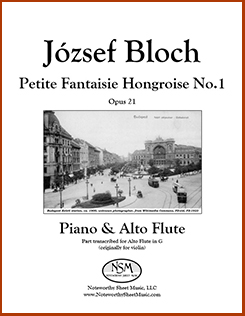 Petite Fantaisie Hongroise No.1, Op.21, by J. Bloch
Petite Fantaisie Hongroise No.1, Op.21, by J. Bloch
Transcribed for Alto Flute and Piano by C.A.Vater
Piano Score and Alto Flute Part, PDF $5.99
József Bloch (1862-1922) was a Hungarian violin virtuoso, composer, and professor at the National Academy of Music and the National Conservatory (www.jewishencyclopedia.com). His Petite Fantaisie Hongroise No.1, Opus 21, was written for piano and violin and published by Bárd, ca. 1901. We thought this piece would work beautifully on alto flute, so we created a transcription of the violin part. In the range written for the Petite Fantaisie Hongroise, the alto flute may evoke the dark, mournful tone of the modern tárogató, which is often referred to as the Hungarian national instrument. We provide both our transcribed alto flute part and a re-notated edition of the piano score.
Alto Flute part, 3 pages; Piano Score, 6 pages; Total, 12 pages.
Preview=================================
For those who would prefer to purchase a professionally-printed hard copy of this piece, rather than the PDF download offered above, our print edition of the Bloch Petite Fantaisie Hongroise No.1, Op. 21 transcribed for Piano & Alto Flute is available directly from NSM for $13.49 plus a $5.95 shipping and handling fee to addresses in the USA. Use the Contact Us form to let us know which hard copy publication(s) you would like to purchase, along with your email contact information and USPS mailing address. We will then send you a PayPal invoice for the sale and, once we receive notice from PayPal that you have paid for the item(s), we will ship your music to the address provided.
Brahms ― Sonata, Op.120 No.1 ― Alto Flute
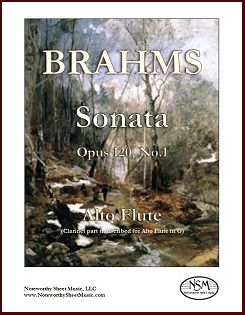 Sonata, Op.120 No.1, by Johannes Brahms
Sonata, Op.120 No.1, by Johannes Brahms
Transcribed for Alto Flute by J.W.Pratt
Alto Flute Part, PDF $8.99
Although written originally for clarinet, Brahms himself created two more versions of his Op.120 sonatas, for violin and viola. John W. Pratt, who transcribed these works for alto flute so expertly, writes in his foreword: "If Brahms was happy with versions for clarinet, viola, and violin, surely he would have welcomed arrangements for alto flute, especially since it is the mellow rather than the clarion aspect of the clarinet that he called on. In making our arrangements for alto flute, the violin versions have been particularly helpful, since the violin has the same lower range as the alto flute, but they required modification for several reasons. One, of course, is that the alto flute cannot play as loudly at the bottom of its range as the violin can. Another is that Brahms gave the violin double stops even though the clarinet is limited to a single voice." Our editions of the two Op.120 sonatas include only the alto flute parts, as Brahms' piano scores are freely available in the public domain. Here is a link to the listing of Op.120 No.1 on IMSLP.org, where the clarinet, viola, and violin versions with piano scores may be found. Our alto flute arrangements are based on the usual piano parts that accompany the clarinet as the solo instrument. The entire transcription of Op.120 No.1 works remarkably well, but the breathtakingly beautiful slow movement played on alto flute will steal your heart away.
Alto Flute part, 9 pages; Total 14 pages.
PreviewBrahms ― Sonata, Op.120 No.2 ― Alto Flute
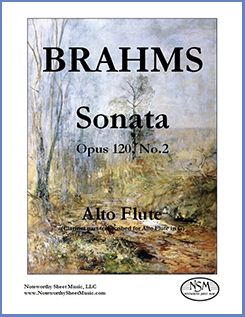 Sonata, Op.120 No.2, by Johannes Brahms
Sonata, Op.120 No.2, by Johannes Brahms
Transcribed for Alto Flute by J.W.Pratt
Alto Flute Part, PDF $8.99
This is the second of Brahms' two clarinet sonatas, transcribed for alto flute by John Pratt. Although written originally for clarinet, Brahms himself created two more versions of his Op.120 sonatas, for violin and viola. Mr. Pratt, who transcribed these works for alto flute so expertly, writes in his foreword: "If Brahms was happy with versions for clarinet, viola, and violin, surely he would have welcomed arrangements for alto flute, especially since it is the mellow rather than the clarion aspect of the clarinet that he called on. In making our arrangements for alto flute, the violin versions have been particularly helpful, since the violin has the same lower range as the alto flute, but they required modification for several reasons. One, of course, is that the alto flute cannot play as loudly at the bottom of its range as the violin can. Another is that Brahms gave the violin double stops even though the clarinet is limited to a single voice." Our editions of the two Op.120 sonatas include only the alto flute parts, as Brahms' piano scores are freely available in the public domain. Here is a link to the listing of Op.120 No.2 on IMSLP.org, where the clarinet, viola, and violin versions with piano scores may be found. Our alto flute arrangements are based on the usual piano parts that accompany the clarinet as the solo instrument.
Alto Flute part, 8 pages; Total, 12 pages.
PreviewBridge – 4 More Short Pieces – Flute or Alto Flute (and Piano)
 Cradle Song, Gondoliera, Mélodie, and Elégie, by Frank Bridge
Cradle Song, Gondoliera, Mélodie, and Elégie, by Frank Bridge
Transcribed for Flute or Alto Flute (and Piano) by J. W. Pratt
Flute Part, Alto Part, PDF $11.99
Like the 4 Short Pieces for Violin and Pianoforte published in transcription by Noteworthy Sheet Music previously, these additional four short pieces by Bridge "provide a fine and delightful introduction to an accessible post-romantic composer who should be better known." Published by Bridge between 1903 and 1911, the works included in our second edition are transcriptions of Cradle Song, written for violin or cello and piano, Gondoliera for violin and piano, and Mélodie and Elégie for cello and piano. Mr. Pratt has created transcriptions of all four pieces for both flute and alto flute, and we include both instrument versions in this combined edition. We think Cradle Song and Elégie are particularly beautiful on the alto flute, but all are effective on either instrument, so we prefer to let our flutists decide on which instrument they choose to play each piece. We provide our flute and alto flute parts only; the original piano scores work well with our transcriptions and are available, along with the violin and cello parts, as free pdf downloads at imslp.org—click the links to access the scores for Cradle Song, Gondoliera, Mélodie, and Elégie.
Flute part, 6 pages; Alto Flute part, 6 pages; Total, 14 pages.
PreviewBridge – 4 Short Pieces – Flute or Alto Flute (and Piano)
 4 Short Pieces, by Frank Bridge
4 Short Pieces, by Frank Bridge
Transcribed for Flute or Alto Flute (and Piano) by J.W.Pratt
Flute Part, Alto Part, PDF $8.99
The 4 Short Pieces by Frank Bridge were written for violin and piano, and first published in 1912. As noted in John Pratt's foreword to the edition, they "provide a fine and delightful introduction to an accessible post-romantic composer who should be better known." The pieces are Meditation, Spring Song, Lullaby, and Country Dance. Mr. Pratt has created transcriptions of the violin parts for both flute and alto flute, and we include both instrument versions in this edition. We think Nos. 1 and 3 sound particularly nice on the alto flute and No. 4 is a splendid romp on the C flute, but all four are effective on either instrument, so we prefer to let our flutists decide on which instrument they choose to play each piece. We provide only our flute and alto flute transcriptions; the piano score, including the original violin part, is available as a free pdf download at imslp.org.
Flute part, 5 pages; Alto Flute part, 5 pages; Total, 14 pages.
PreviewBurleigh - Southland Sketches, Nos. I, III, IV - Alto Flute or Flute (& piano)
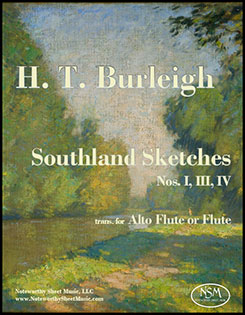 Southland Sketches, Nos. I, III, IV, by H. T. Burleigh
Southland Sketches, Nos. I, III, IV, by H. T. Burleigh
Transcribed for Alto Flute or Flute (and piano) by C. A. Vater
Alto Flute part and Flute part, PDF $9.96
Harry Thacker Burleigh was an acclaimed African-American singer, music editor, and composer whose adaptations of African-American spirituals became famous. His Southland Sketches, which were composed for violin and piano and published by G. Ricordi in 1916, are a fine example of Burleigh’s quintessential American style. The original composition included 4 movements. Our edition excludes the second movement, but adapts three of the original four miniatures for either alto flute or flute. We provide only the transcribed alto flute and flute parts, as they have been designed to work well with the piano part in the original score for violin and piano which is available as a good quality, free pdf download from imslp.org. Performers may choose to play all three of these pieces on either flute or alto flute, or switch instruments between sketches, depending on personal preference.
Alto Flute part, 6 pages; alternate Flute part, 6 pages; Total,18 pages. (pdf of piano accompaniment is freely available at imslp.org)
PreviewCoste - Cavatine - Afl + Pf
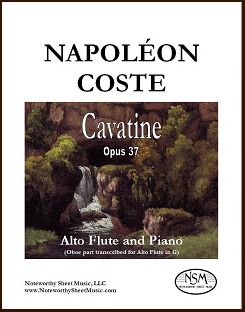 Cavatine, Op.37, by Napoléon Coste
Cavatine, Op.37, by Napoléon Coste
Transcribed for Alto Flute and Piano by C.A.Vater
Piano Score and Alto Flute Part, PDF $8.25
Napoléon Coste (1805-1883) was born in a small village in the Départment of the Doubs, France. He began to play guitar at the age of 6, studying with his mother who was an accomplished guitar performer. Napoléon himself began teaching and performing on guitar as a teenager. At age 24 he moved to Paris, where he studied under Fernando Sor, the renowned Spanish classical guitarist and composer. Coste quickly established himself as a virtuoso and is widely acknowledged as the dominant French guitarist of his era.
Coste became famous not only as a guitar soloist, but also as a major composer of some 60 works, most of which were written for guitar. His Op.37 "Cavatine" is a short, single-movement piece composed for piano and oboe (or violin or flute). The work is lovely, melodic but lively in places; it falls nicely within the range of the alto flute and sounds appealing and completely natural on that instrument. The Noteworthy Sheet Music edition includes a score for piano and alto flute, in addition to the transcribed alto flute part.
Alto Flute part, 3 pages; Piano Score, 8 pages; Total, 16 pages.
PreviewCoste - Les Regrets - Afl or Fl (or Ob, Vn) and Pf (or Guitar, Harp)
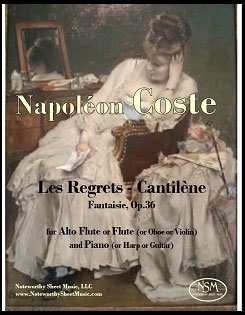 Les Regrets-Cantilène, Op.36, by Napoléon Coste
Les Regrets-Cantilène, Op.36, by Napoléon Coste
Transcribed for Alto Flute or Flute (or Oboe or Violin) and Piano (or Harp or Guitar) by C.A.Vater
Score, Alto Flute Part, and alternative Flute (or Oboe or Violin) Part, PDF $5.99
Napoléon Coste (1805-1883) became famous not only as a guitar soloist, but also as a major composer of some 60 works, most of which were written for guitar. His music is in the romantic French style and appreciated for its originality. His Fantaisie, Op.36, Les Regrets-Cantilène, is a short, single-movement piece written for oboe or violin with piano or harp or guitar. We created our Noteworthy Sheet Music edition from the difficult-to-read manuscript version in the public domain, available on imslp.org. We include a score in concert pitch and a part suitable for flute, oboe or violin, as well as a part transcribed for alto flute in G. The piece falls nicely within the sweet range of the alto flute and our transposition sounds appealing and completely natural on that instrument. In fact, Les Regrets-Cantilène is gorgeous on either flute or alto flute. Melodic and sentimental, the work is not overly demanding technically and should appeal to players of a moderate or higher skill level.
Score, 4 pages; Alto Flute part, 1 page; Flute (or Oboe or Violin) part, 1 page; Total 8 pages.
Preview